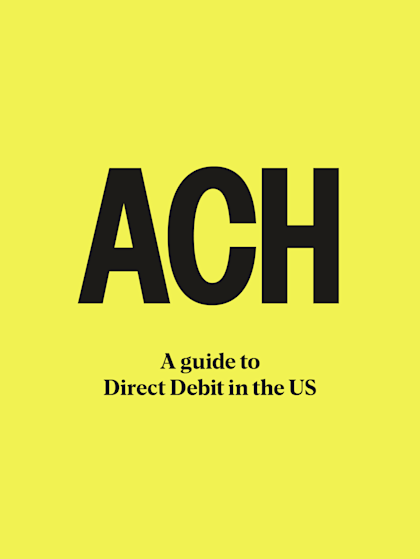
What are ACH payments & how do they work?
Last editedSep 20253 min read
An ACH payment is a type of electronic bank-to-bank payment in the US. It’s made via the ACH network, rather than going through the card networks such as Visa or Mastercard. An ACH payment is also referred to as an ACH transfer or ACH transaction.
What is ACH?
ACH (Automated Clearing House) is a network used for electronically moving money between bank accounts across the United States. It’s run by an organisation called Nacha (previously NACHA - National Automated Clearing House Association), and may also be referred to as the ACH network or ACH scheme.
Payment processing via the ACH network has existed since the 1970s. ACH moved financial transactions worth more than $72.6 trillion in 2021, an increase of over 17 percent from the previous year. These included government, consumer, and business-to-business transactions, as well as international payments.
The ACH scheme encompasses a number of different types of payments, which we explore below
What is an ACH payment?
An ACH payment is a type of electronic bank-to-bank payment in the US. It’s made via the ACH network, rather than going through the card networks such as Visa or Mastercard. An ACH payment is also commonly referred to as an ACH transfer or ACH transaction.
There are two main categories of ACH payments:
Direct Deposits
Direct Payments
Direct Deposit covers all kinds of deposit payments from businesses or government to a consumer. This includes payroll, employee expense reimbursement, government benefits, tax and other refunds, and annuities and interest payments.
Direct Payment covers the use of funds for making payments, either by individuals or organizations. This type of ACH transaction is the primary focus of this guide - any reference to ACH payment, ACH transfer, or ACH transaction in this guide refers to Direct Payments, unless stated otherwise.
Types of ACH transfers
There are two main types of ACH transfers - ACH credits and ACH debits. They largely differ by how the funds are transferred between accounts - with ACH credits the funds are pushed into an account, while with ACH debits the funds are pulled out of an account. There are a number of different types of ACH debits.
Looking for an easy & affordable way to collect ACH payments?
GoCardless saves merchants time, money & stress collecting ACH payments.
How long does an ACH payment take to process?
ACH debit is not an instant payment method. Payments may take more than 3 working days to appear in your bank account, and the time of day you submit the ACH file to your bank is important. The process may also fail for various reasons, resulting in potentially longer processing times. Read more about ACH timings here.
Benefits of ACH
Using the US bank-to-bank infrastructure to process payments brings significant benefits for companies and organizations needing to take payments on an ongoing basis. Notably:
Low cost - Since an ACH payment is not routed through the relatively expensive card networks, it tends to be a cheaper method for electronically transferring funds.
High retention - Credit and debit cards expire, leading to involuntary churn. With an ACH payment, a bank account is the source of funds and as such the risk of involuntary churn is significantly reduced.
Open to anyone - Anyone with a US bank account is able to pay via the ACH scheme. This includes both businesses and consumers.
One disadvantage of ACH payments, however, is that they are not instant (more on this in Chapter 3).
Are ACH payments right for my business?
To determine if accepting ACH payments is right for your business, there are several questions you need to answer:
Does your business currently take recurring payments?
Does a significant proportion of your customers currently pay by paper checks?
Does a significant proportion of your customers currently pay by credit card?
Do the fees for ACH processing save you money compared to credit card fees?
Would you be able to convert your credit-card-using customers to pay by ACH instead?
Are any members of your customer base, or potential customer base, uncomfortable with making online payments via credit card?
Is your business currently ineligible to accept credit and debit cards (for example, by being in a high-risk business category)?
If you answer ‘yes’ to any of these questions, your business is likely to benefit from accepting ACH payments.
Cost of ACH payments
The median internal cost for processing ACH payments is $0.29.
However, the total cost associated with accepting ACH payments varies depending on a number of factors.
Wire transfer vs ACH transfer
Speed comparison
The wire network processes transactions in real time, so wire transfers are usually delivered within the same day. An ACH payment, on the other hand, can take several days to settle (more on this in Chapter 3).
Cost comparison
Sending a wire transfer within the US is expensive, costing the payer an average $25 per transaction (and fees can be even higher for international transfers). On top of that, some financial institutions may also charge the recipient a fee to receive the funds.
An ACH payment can be orders of magnitude cheaper per transaction than a wire transfer - something we explore more in Chapter 2.
Which is better?
Because of their high cost and speed, wire transfers are best for large or time-sensitive transfers, either within the US or abroad. But if time-sensitivity isn’t an issue, an ACH payment offers significant advantage over a wire transfer, because of its lower cost.
Key takeaways
ACH payments are a type of electronic bank-to-bank payment in the US.
ACH payments differ from card payments like those made via Visa or Mastercard.
ACH Direct Payments (the type of ACH payments this guide is concerned with) are useful because they're low cost, accessible to many American consumers, and help businesses retain their customers.
ACH Direct Payments are worth considering by any business taking recurring payments.
With no stress and no complicated financial paperwork GoCardless makes getting paid by US customers super-simple and hassle-free.
We can help
GoCardless helps you automate payment collection, cutting down on the amount of admin your team needs to deal with when chasing invoices. Find out how GoCardless can help you with ad hoc payments or recurring payments.


